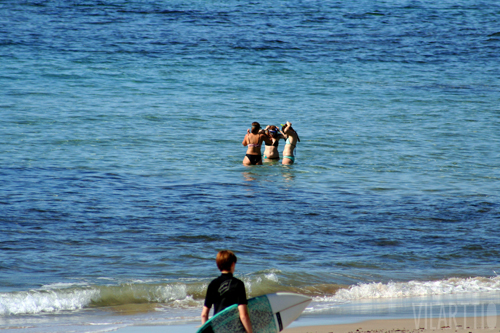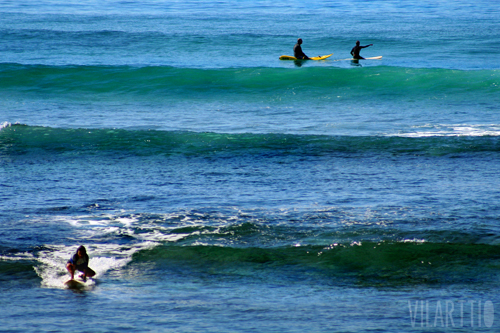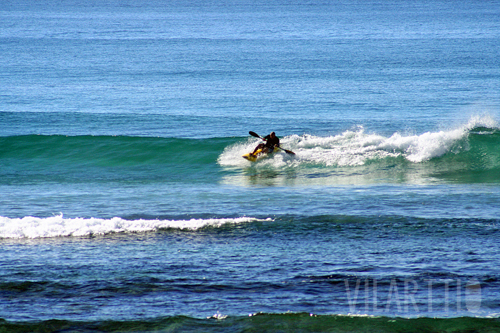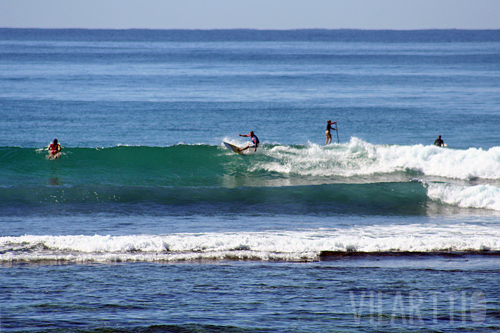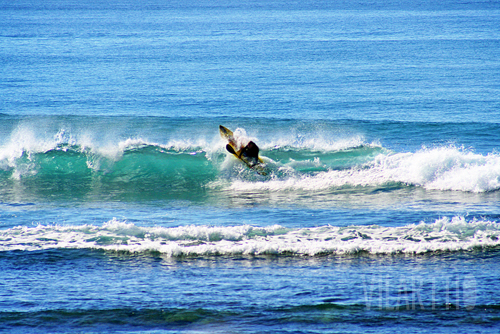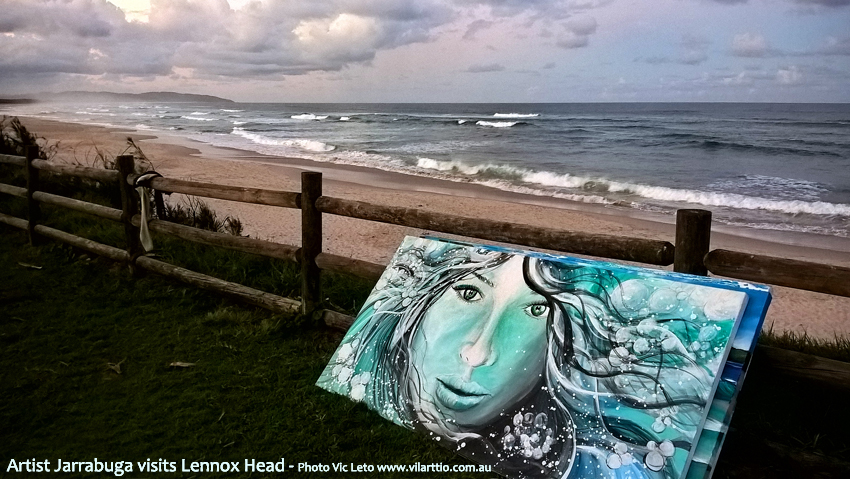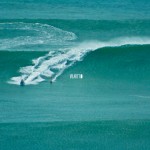The Stairway to Heaven
Here is a nice slice from ‘hanging out’ on The Stairway to Heaven on the a weekend 14 – 15th May. The weather is as good as it gets. Cool nights with perfect warm sunny blue sky days equalled with water temps in the mid 20’s degree C. Topped with excellent water clarity of magnificent colour, light off-shore winds and some nice little waves.
Surf on SAT. 14TH MAY 2016
And some pics of friends young and old (ok, more like old school) in the Lennox playground…
Artist Jarrabuga visits Lennox Head
Big Boulders Tow-In Day 2006
10 April marks ten years since I captured these images of Tow-In Surfers taking on !HUGE SURF! rolling into the Lennox Head region.
To get some perspective of just how big it was look at the above photo (Boulders to Flatrock) and zoom into the foreground headland and compare the size of the people spectating on the headland. Also, if you are familiar with this surf break, zoom into the peg and you will know what I am talking about.
In the same picture, in the very distance background, waves can be seen breaking across Flatrock. The feature being the centerpiece of the picture with waves breaking from Sharps through Skinners Head to Boulders Beach.
Over the entire day only a handful of souls managed to paddle into a couple of waves at Lennox Point.
Many HUGE very good ride-able waves were breaking way out from usual locations and 4 Jet Ski assist tow-in riders led by Lennox legend Billy Hession tracked an area at The Cove at the southern end of Lennox Headland.
Below sequences Geoff Doig:
2016 Easter Full Moon
Ben King Memorial Paddle Out – Byron Bay 2006
The 21st March signified ten years since the Ben King Memorial Paddle Out. Here are three of the most iconic shots I captured on the day: The Gathering (on the beach), The Paddle Out and The Circle formation in the water.



This was a pretty difficult assignment to shoot back in the days before ‘Drones’ and I must praise motorised glider pilot Dieter Hostmann from Tyagarah Airfield for his flying skills and manoeuvring to get help me in best position to get the shots. It was a pretty tight fit in the cockpit as I sat by his side and only had a porthole opening on the right side window about the size of a CD case to point the camera out of and which was located at about my chest height.
Also thanks to Paul Full of Ace Photo Shop in Ballina for tidying up the shots with his digital imaging expertise.
In respect of Jen King (Ben’s widow) wishes these images are not for sale and are for display purposes only.
Barefoot Breezy Ad
X-Vacation
Where else did you think they have been hanging out all this time !?! Well Byron Bay of course…
As an X Files fan back in the day, I painted this tile around 1994. My motivation was that Mulder and Scully were never seen anywhere near such a clean, bright, colourful, environment.
In fact every time they entered some dark dingy place I would be on the edge of my seat begging (usually Mulder) to retreat “NO…don’t go down there, NO don’t go down there… NO!!!” of course further and deeper into the darkness they would go…
So all these years later, just like everyone else who doesn’t want to leave Byron after their X-tended vacation, its time to put down the sunscreen and head back to work.
Sharknado at Lennox beach 1st Anniversary
The Lennox Sharknado landed me right in the middle of the ‘Cull to Cuddling’ sharks debate…
It’s a year now since the shark was sucked up out of the sea and fell from the sky and deposited on Lennox Head beach a victim of Cyclone Marcia.
Well, supposedly that’s what happened, if you believe the ‘Immedia’.
After my initial Facebook post the mainstream ‘Immedia’ lifted comments to help create a MAS-MIS-INFORMATION SHARKNADO spiralling out of control to become a worldwide trending topic that week.
If you missed the story of the most significant beach landing since Normandy you can read this article I wrote in response for the Lennox Wave magazine:
A year on, and leaving the silliness of the Lennox Sharknado behind, according to the International Shark Attack File, 2015 recorded the highest ever number of shark attacks worldwide since the collection of data in 1958. The count recorded 98 verified unprovoked attacks, and 6 of those fatal. While attacks did increase, fatality rates kept to the average.
With the added fuel of ‘Immedia’ hype, the temperature between approaches of ‘Cull to Cuddle’ in the shark mitigation debate soared to RED HOT.
The debate is inadvertently providing a ‘Sharknado type SPIN’ of distraction, letting governments off the hook by diverting attention away from the true culprits pillaging and plundering our oceans.
In response to the shark mitigation debate, many concerned about shark conservation have raised these statistics as insignificant when compared to road accidents, dog attacks, snake bite, deaths caused by hippopotamus and falling coconuts. They point out the fact that over 100 million sharks are killed by humans each year. That shark bites are simply a case of innocently mistaking humans for their prey after just sampling a taste.
But no matter how low the percentages, these statistics are not just as trivial as unforced errors in a tennis match. At the other end of the court are human victims.
The implications reach further than the death of some victims (or the ‘lucky’ ones) that survive and are left inflicted with horrendous pain, suffering and grief. The post-traumatic stress can carry on to victims’ families, friends, rescuers, witnesses and bystanders. Indeed, the PTS is penetrating deeper into the psyche of communities, particularly close-knit smaller coastal towns like here in Northern NSW.
After unfortunately tallying too well in the 2015 percentage count, the mood here toward sharks has swung all the way from once carefree, then nonplus, to unnerving and now fraught with anxiety for some. A rare few remain blasé, some have called for more mitigation action, and some have drastically called out “cull the bastards!”
The conservation side disagree; believing sharks are misunderstood, should be left in peace, nurtured and deserve a ‘cuddle.’
While scientists and researches claim otherwise, anecdotally many long term surfers and ‘old-salt sea farers’ say they have witnessed and encountered more shark numbers ‘than usual’ the past few years. Some ‘old-salts’ go as far to say protection of sharks (particularly Great Whites) has become pedantic and they are no longer endangered, have recovered and indeed increased in numbers. (There is no conclusive evidence to claims of both sides.)
The majority of surfers and ‘salts’ are genuinely concerned for the ocean’s welfare and do respect it and want it protected. They are out there every day with many years of experience observing with their ‘own brand of science’ and something intuitive tells them the balance has changed.
Yet they believe their message is being misunderstood. Those asking for a ‘controlled cull’ are not calling for ‘genocide’ and are offering opinions seriously as quick, simple, traditional and inexpensive option. They refer not only to ‘the customary way’ but also some Polynesian cultures who actually apply culls to individual threats. And documented cases of Orcas killing a Great White, to then find all the G.W.’s in the region move on. Immediately. And great distances at that, like California to Hawaii.
Slamming back this option, some conservationists responses roar with passion about shark protection and their territorial rights. Some comment simplistically with “stay out of the water”. Other comments go down murkier waters aimed at victims “it’s the sharks’ territory and served you right for getting bitten.” And, even more spiteful comments like “cull the surfers and humans.”
While everyone is entitled to their opinions, these unwarranted and disturbing comments coming from ‘so called conservationists’ have no place in a sensible shark mitigation debate. To somehow exclude and negate the human element is at best hypocritical and worse insensitive and disrespectful toward victims.
How have innocent ocean goers asking for protection become the target of hate comments that inappropriately brand them as irresponsible invaders intruding and interfering in the sharks’ domain? For mentioning the word ‘cull’ the ‘salts’ have been cast into the same net and scale of blame as those responsible for the mass slaughters in the Asian shark finning market.
There needs to be perspective applied to the debate and understanding the difference between discussions of local mitigation options compared to other global non-sustainable commercial fishing statistics.
We humans supposedly evolved from the sea and have an affinity to return, regardless of whether the ocean is deemed the sharks’ territory. In fact, just by being a species sharing the planet we have some rights to enter the ocean as a playground. However, we don’t have an exclusive right to work our dominance over the oceans for corporate commercial gain.
The debate of shark mitigation has led to a divide between ocean loving people fighting each other with the same end-goal, while deflecting from ‘the real’ bigger picture issues.
Everyone should take the lead set by the shark victims support group ‘Bite Club’ which provides comradery enabling members to talk about how one is feeling and coping with PTSD. The key to the therapeutic benefits of the group, is knowing you are not alone and members have something (rare) in common and survivors can be heard with empathy and compassion.
But the ‘Cull to Cuddle’ opinions within Bite Club also differ greatly. However, regardless of any individual opinion, the most important rule among the group is whatever side of the debate you lean, your opinion is respected and the focus above all, is the human element.
First Rule of Bite Club: “Talk about it!”
A MUST WATCH urging respect from both sides of the contentious and polarised views between ‘culling to cuddling’ sharks is presented here by Bite Club member Dale Carr: https://www.youtube.com/watch?v=w-JrHPpKOKE
In an ideal world, protection of sharks as the apex predator is vital to keep the ocean’s ecosystem in check. But what happens when the ecosystem is already way out of check? Regardless of shark numbers (proven to have risen or fallen) we at least seem to be experiencing an increase of (Great White) sharks much closer to our shorelines.
The larger pool of the ocean as a whole is virtually empty and in a state of collapse desperately needing rescuing while a debate (argument) only centres on ‘the play around our shorelines’.
Here in Northern NSW as the example, an apparent abundance of sea life is attracting shark presence and indicates a healthy ecosystem. But when casting the net much further from just this thriving pocket of coastline to the wider majority of the world’s ocean, could the sharks now be queuing up at one of the rare eateries left offering a meal?
Could it also be that when we factor in more people than ever interacting in an ocean with worldwide decreasing sea-life in the food chain, it is equating to more sharks unfortunately sometimes (and now more often) accidently choosing from the wrong menu?
Regardless of whether this can be proven, it’s time to turn up the heat and raise pressure on government accountability for allowing our sea life to be slaughtered by approving such beasts as Super Trawlers and other en-masse non-sustainable fishing methods. This includes certain shark cage diving practises (but that’s another separate long story.)
We need a sensible and above all, respectable shark mitigation debate. Instead of arguing among ourselves whether sharks are landing on our beaches as a result of falling from the sky, let’s instead band together and turn attention to focus back on the real big-picture issue problem of depleting sea life in our oceans.
This link provides a very compelling account as to just how broken the ocean is: http://www.theherald.com.au/story/1848433/the-ocean-is-broken/






























